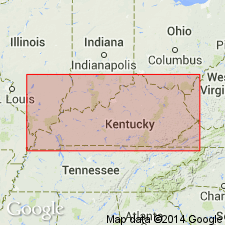
- Usage in publication:
-
- Four Corners formation
- Modifications:
-
- Informally named
- Dominant lithology:
-
- Shale
- Coal
- AAPG geologic province:
-
- Appalachian basin
Summary:
Breathitt Formation is informally elevated to group rank and subdivided into the following eight informal formations: Pocahontas, Bottom Creek, Alvy Creek, Grundy, Pikeville, Hyden, Four Corners, and Princess formations. Four Corners includes Magoffin Member (reassigned) at base, Haddix coal, member N, Hazard coal, Cowcreek shale member (informally named), Hazard No. 7 coal, member O, Francis coal, Bulan shale member (informally named), and Hindman coal. Age is Middle Pennsylvanian (Atokan). [Revisions made in this paper are strongly contested by C. Rice and other USGS scientists who work in this area (oral commun., 9/3/93).]
Source: GNU records (USGS DDS-6; Reston GNULEX).
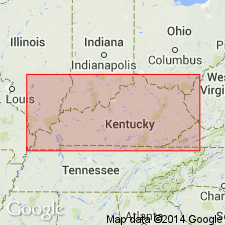
- Usage in publication:
-
- Four Corners Formation
- Modifications:
-
- Original reference
- Dominant lithology:
-
- Shale
- Coal
- AAPG geologic province:
-
- Appalachian basin
Summary:
Four Corners Formation of Breathitt Group is formally named in this report for a series of four roadcuts near Hazard, KY. Base of the unit is marked by the Magoffin Member, a widely mapped marine marker bed. Underlies the Stoney Fork Member of the Princess Formation (new) and overlies the Hyden Formation (new). Unit is probably the most important formation for coal resources. Reaches a maximum thickness of <275 m. Formation thins to the north and is difficult to distinguish from adjacent units in northeastern KY. Extends to adjacent VA, WV, and TN, though exposures in TN are sporadic. Only a generalized age of Pennsylvanian given here. According to the author, formal nomenclature presented in this report for units occurring in KY has been accepted by the Kentucky Stratigraphic Nomenclature Committee. Units that occur largely outside KY are considered informal. Report includes correlation charts, cross sections, and measured sections.
Source: GNU records (USGS DDS-6; Reston GNULEX).
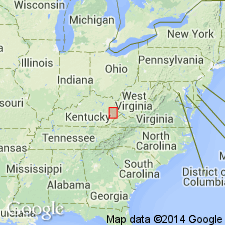
- Usage in publication:
-
- Four Corners Formation
- Modifications:
-
- Areal extent
- AAPG geologic province:
-
- Appalachian basin
Summary:
Fluvio-deltaic Pikeville, Hyden, and Four Corners Formations of the Breathitt Group in eastern KY represent three superimposed 3rd-order composite sequences, their unconformable boundaries corresponding with maximum flooding. The Breathitt is up to 950 m thick in eastern KY and comprises delta-plain facies of siltstone, clay-rich shale, sandstone, coal, siderite, and rare limestone. Calculated average ages of the base and the top are 323 Ma and 303 Ma. The four major marine members at the bases of the Pikeville, Hyden, Four Corners, and Princess Formations (Betsie, Kendrick, Magoffin, and Stoney Fork) are estimated to occur at 2.5 Ma intervals, which equates with the 3rd-order cyclicity of Vail and others (1977).
Source: GNU records (USGS DDS-6; Reston GNULEX).
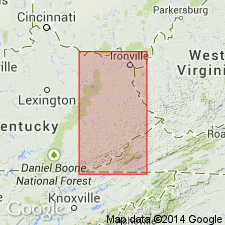
- Usage in publication:
-
- Four Corners Formation
- Four Corners unit
- Modifications:
-
- Not used
- AAPG geologic province:
-
- Appalachian basin
Summary:
Four Corners Formation of Breathitt Group of Chesnut (1992); Four Corners unit (informal) in Breathitt Formation of Rice and others (1994, GSA Spec. Paper, p. 126, citing Chesnut, 1989). Not used. [Rocks assigned to the Four Corners Formation by Chesnut (1992) are in middle of Breathitt Formation, from base of Stoney Fork Member (= top of lower Broas, Hindman, or Hazard No. 9 coals) down to base of Magoffin Member.]
Source: Publication.
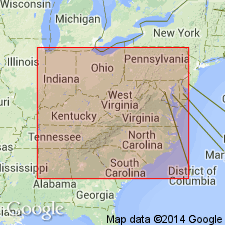
- Usage in publication:
-
- Four Corners Formation
- Modifications:
-
- Areal extent
- AAPG geologic province:
-
- Appalachian basin
Summary:
Corr. chart. Four Corners Formation of Breathitt Group. Mostly sandstone, siltstone, shale, and coal. Recognized in eastern and southeastern Kentucky. Lies below Princess Formation and above Hyden Formation, both of Breathitt Group. Age is Middle Pennsylvanian (Westphalian; Atokan).
In eastern Kentucky includes (descending) lower Broas (Princess No. 4) coal zone, Bulan shale member (informal), upper Peach Orchard (Hazard No. 8) coal zone, lower Peach Orchard (Hazard No. 7) coal zone, Arnett Member, Hazard (Prater) coal zone [= Winifrede coal zone of West Virginia, which Eble and others (2009, Kentucky Geol. Survey, ser. XII, Spec. Pub. 10, fig. 5.2) placed at the Duckmantian/Bolsovian (Westphalian B/C) boundary on basis of miospores], Haddix coal zone, and Magoffin Member at base.
In southeastern Kentucky [Upper Cumberland River district] includes (descending) Black Mountain coal bed, High Splint (No. 12) coal bed, Arnett Member, Red Springs coal bed [= Winifrede coal zone of West Virginia, which Eble and others (2009, Kentucky Geol. Survey, ser. XII, Spec. Pub. 10, fig. 5.2) placed at the Duckmantian/Bolsovian (Westphalian B/C) boundary on basis of miospores], Low Splint (Morris No. 11) coal bed, Reynolds Sandstone Member, and Magoffin Member at base.
[Unpublished collections from overlying Stoney Fork Member of Princess Formation in Kentucky, and its equivalents, informal Lake City member of Cross Mountain Formation in Tennessee and Blunt Run (Boggs) limestone of Pottsville Group in Ohio, yielded distinctive conodonts correlative with the marine Aegir bed (=base of Westphalian C) thus shifting the Four Corners, Vowell Mountain, lower part of Cross Mountain, and upper part of Pottsville, downward into Westphalian B (R.G. Stamm, USGS, pers. commun., Oct. 17, 2013).]
[See also Chesnut, 1997 (revised Oct. 12, 1999), Stratigraphy of the coal-bearing strata of the Eastern Kentucky coal field, available online through the Kentucky Geol. Survey (http://www.uky.edu/KGS/coal/coalcorrel.htm) and geologic descriptions of stratigraphic units in the Kentucky Geological Survey database (http://kgs.uky.edu/kgsmap/KGSLitho/lithoSearch.asp#).]
Source: Publication.
For more information, please contact Nancy Stamm, Geologic Names Committee Secretary.
Asterisk (*) indicates published by U.S. Geological Survey authors.
"No current usage" (†) implies that a name has been abandoned or has fallen into disuse. Former usage and, if known, replacement name given in parentheses ( ).
Slash (/) indicates name conflicts with nomenclatural guidelines (CSN, 1933; ACSN, 1961, 1970; NACSN, 1983, 2005, 2021). May be explained within brackets ([ ]).

